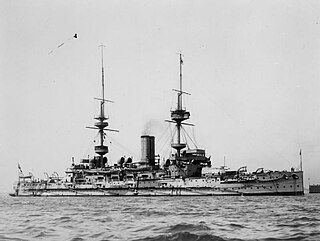
The third HMS Illustrious of the British Royal Navy was a Majestic-class pre-dreadnought battleship. The ship was built at the Chatham Dockyard; her keel was laid down in March 1895, her completed hull was launched in September 1896, and she was commissioned into the fleet in April 1898. She was armed with a main battery of four 12-inch (305 mm) guns and a secondary battery of twelve 6-inch (152 mm) guns. The ship had a top speed of 16 knots.

HMS Magnificent was one of the nine Majestic-class pre-dreadnought battleships of the Royal Navy. She entered service in late 1895 with the Channel Fleet, remaining with the fleet through its subsequent reorganisation into the Atlantic Fleet. In 1905, an explosion caused the deaths of 18 men but she remained in service until 1906, after which she underwent a refit. She served with the Home Fleet for most of her pre-war service.
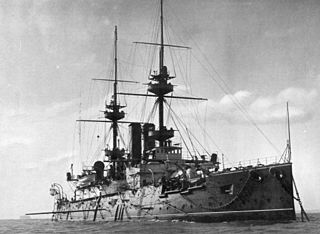
HMS Jupiter was a Majestic-class pre-dreadnought battleship of the Royal Navy. Commissioned in 1897, she was assigned to the Channel Fleet until 1905. After a refit, she was temporarily put in reserve before returning to service with the Channel Fleet in September 1905. In 1908 and rendered obsolete by the emergence of the dreadnought type of battleships, she once again returned to the reserve, this time with the Home Fleet. After another refit, she had a spell as a gunnery training ship in 1912.

HMS Bat was a Palmer-built three funnel, 30 knot torpedo boat destroyer ordered by the Royal Navy under the 1895 – 1896 Naval Estimates. She was the third ship to carry this name since it was introduced in 1815 for a revenue cutter in service until 1848. Bat was classified along with similar vessels as a C-class destroyer in 1913.
HMS Electra was a Clydebank-built, three-funnelled, 30-knot destroyer ordered by the Royal Navy under the 1895–1896 Naval Estimates. She was the fourth ship to carry this name since it was introduced in 1806 for a 16-gun brig-sloop.

HMS Mildura was a Pearl-class cruiser built for the Royal Navy in the late 1880s. Originally named HMS Pelorus, she was renamed after an Australian town in April 1890. Per the Imperial Defense Act of 1887, she served primarily in Australian waters.

HMS London was the lead ship of the London class of pre-dreadnought battleships built for the British Royal Navy. The Londons were near repeats of the preceding Formidable-class battleships, but with modified armour protection. The ship was laid down in December 1898, was launched in September 1899, and was completed in June 1902. Commissioned the same month, she served with the Mediterranean Fleet until early 1907. She was assigned to the Nore Division of the Home Fleet for nearly a year before transferring to the Channel Fleet. Rendered obsolete with the emergence of the new dreadnoughts in late 1906, she underwent an extensive refit in 1909, after which she served with the Atlantic Fleet. She was assigned to the Second Home Fleet in 1912 as part of the 5th Battle Squadron, and was temporarily fitted with a makeshift ramp for experiments with naval aircraft until 1913.
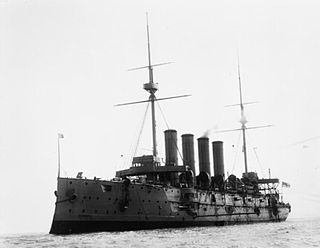
HMS Diadem was the lead ship of the Diadem-class of protected cruiser in the Royal Navy.

HMS Amphitrite was a ship of the Diadem-class of protected cruisers in the Royal Navy, which served in the First World War.

HMS Ariadne was a Diadem-class protected cruiser of the Royal Navy, which was launched in 1898, In March 1913, she was converted to a stokers' training ship and in 1917 was converted to a minelayer and assigned to the Nore Command. She was torpedoed and sunk off Beachy Head by the German submarine UC-65 on 26 July 1917.

HMS Europa was a ship of the Diadem-class protected cruisers in the Royal Navy. She was built by J&G Thompson of Clydebank and launched on 20 March 1897.
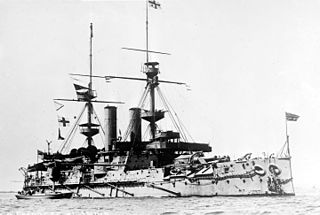
HMS Empress of India was one of seven Royal Sovereign-class pre-dreadnought battleships built for the Royal Navy during the 1890s. The ship was commissioned in 1893 and served as the flagship of the second-in-command of the Channel Fleet for two years. She was transferred to the Mediterranean Fleet in 1897, during which time Empress of India was assigned to the International Squadron blockading Crete during the uprising there. She returned home in 1901 and was briefly assigned as a coast guard ship in Ireland before she became the second flagship of the Home Fleet. The ship was reduced to reserve in 1905 and accidentally collided with the submarine HMS A10 the following year. Empress of India was taken out of service in early 1912 and accidentally struck a German sailing ship while under tow. She was sunk as a target ship in 1913.

HMS Ramillies was a Royal Sovereign-class pre-dreadnought battleship of the Royal Navy, named after the Battle of Ramillies. The ship was built by J. & G. Thompson at Clydebank, starting with her keel laying in August 1890. She was launched in March 1892 and commissioned into the Mediterranean Fleet as flagship the following October. She was armed with a main battery of four 13.5-inch guns and a secondary battery of ten 6-inch guns. The ship had a top speed of 16.5 knots.

HMS Pandora was a Pelorus-class cruiser of the Royal Navy. There were eleven "Third class" protected cruisers in the class, which was designed by Sir William White. While well armed for their size, they were primarily workhorses for the overseas fleet on "police" duties and did not serve with the main battlefleet.

Admiral Sir Robert Swinburne Lowry was a Royal Navy officer who became Admiral Commanding on the Coast of Scotland.

HMS Diana was an Eclipse-class protected cruiser built for the Royal Navy in the mid-1890s.

HMS Desperate was a two funnel, 30-knot destroyer ordered by the Royal Navy under the 1894 – 1895 Naval Estimates. She was launched in 1896, served in Home waters and the Mediterranean before World War I. She was based in Portsmouth during the war and was sold for breaking in 1920.

HMS Angler was a two-funnel, 30-knot destroyer ordered by the Royal Navy under the 1895 – 1896 Naval Estimates. She was the second ship to carry this name. She was launched in 1897, served at Chatham and Portsmouth and was sold for breaking in 1920.
HMS Ostrich was a Fairfield three-funnel, 30-knot torpedo boat destroyer ordered by the Royal Navy under the 1898 – 1899 Naval Estimates. In 1913 she was grouped as a C-class destroyer. She was the first Royal Navy ship to carry this name. She spent most of her operational career in home waters, operating with the Channel Fleet as part of the Portsmouth Instructional Flotilla, and was sold for breaking in 1920.
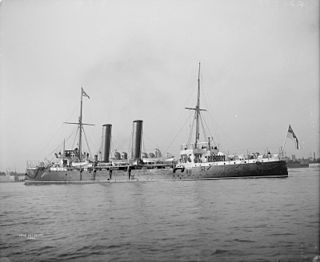
HMS Intrepid was an Apollo-class protected cruiser of the Royal Navy built on the River Clyde and launched in 1891. She was subsequently converted as a minelayer in the latter half of her career and ultimately sunk as a blockship during the Zeebrugge Raid on 23 April 1918.


















